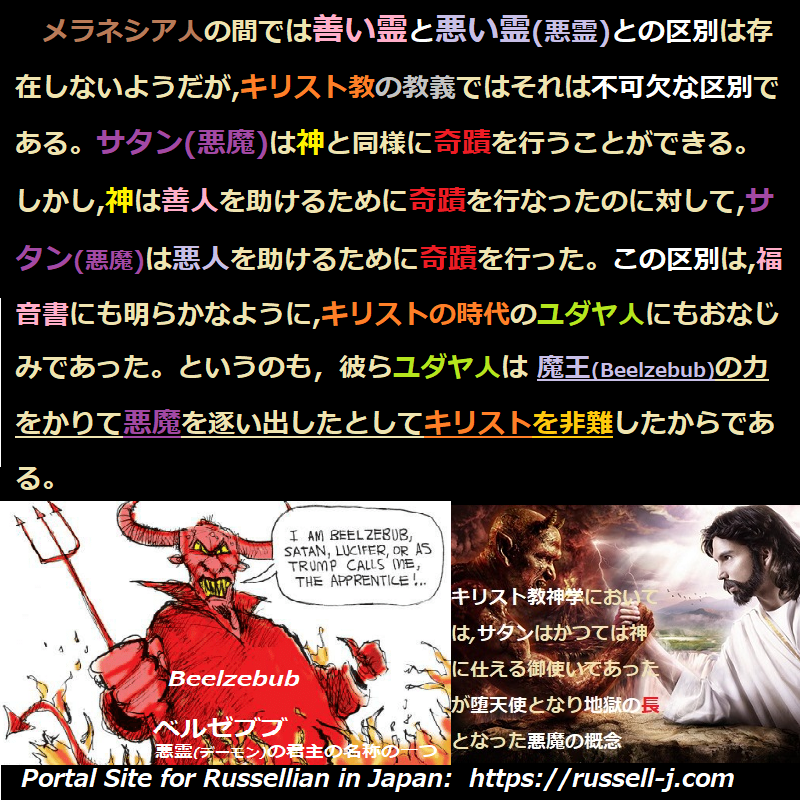
魔女術(witchcraft)の問題(subject 主題/テーマ)及びより大きな魔法(magic)や呪術(socery 呪術(じゅじゅつ)or邪術:超自然的・神秘的なものの力を借りて望む事柄を起こさせること)の問題(主題)は,興味深いと同時に明確ではない(はっきりしない)問題(主題)である。人類学者たちは,ごく原始的な人種の間にさえ,魔法と宗教の間には区別があることを発見している。しかし,彼らの(判断)基準(criteria)は彼ら人類学者自身の科学(=人類学)には疑いなく適しているとしても,我々が降霊術(necromancy) の迫害(注: 降霊術が行われる時になされる迫害)に興味を抱く時に必要な(要求される)基準とはいささか異なっている(訳注:津田氏は 「the persecution of necromancy」を「魔法を追放すること」と訳出)。こうして,リヴァース(William Hasse R. Rivers, 1864-1922:英国の社会人類学者)はメラネシアに関する非常に興味深い本『医術,魔法,宗教』(1924刊年)のなかでこう言っている。「私が魔法について語る時,私が意味しているのは人が儀式を行う一連の過程であり,その儀式の効力はそれを行なう人自身の力あるいはこれらの儀式で使用されるある対象物(objects 物体)や過程の中に内在あるいは帰属していると信じられている力に依存している。これに対し,宗教は,その効力がある種の崇高な力(higher power 神)やその介在が祈願(supplication)や(神々の怒りの)なだめ(propitation)の儀式によって求められるところのある種の力,に依存する一群の過程からなっている」。このような定義(の仕方)は,一方では聖なる石のようなある種の無生物の不思議な力(strange power)を信じ,他方では非人間的な霊を人間よりも優れているとみなす,ような人々を扱う時には適したものである。このどちらも,中世のキリスト教徒やイスラム教徒(マホメット教)については,必ずしも真実ではない。確かに,賢者の石(注:the philosopher’s stone:中世ヨーロッパの錬金術師が鉛などの卑金属を金に変える際の触媒となると考えた霊薬)や不老長生の薬(the elixir of life)に不思議な力が帰せられたが,これらのものはほとんど科学的なものに分類可能なものであった。(即ち)それらは実験によって探し求められ,予想される性質(属性)は,ラジウムの中に見出される性質(属性)が不思議だと思われる以上に不思議なものではほとんどない。そして,魔法は,中世においてそう理解されたように,常に,悪魔ではなく霊の加護を祈願した。メラネシア人の間では,善い霊と悪い霊(悪霊)との区別は存在しないようだが,キリスト教の教義ではそれは不可欠な区別である。サタン(悪魔)は,神と同様に奇蹟を行うことができる。しかし,神は善人を助けるために奇蹟を行なったのに対して,サタン(悪魔)は悪人を助けるために奇蹟を行った。この区別は,福音書にも明らかなように,キリストの時代のユダヤ人にもおなじみであった。というのも,彼らユダヤ人はキリストを魔王(Beelzebub ベルゼバブ/ベールゼブブ)の力をかりて悪魔を逐い出したとして(キリストを)非難したからである。中世における呪術(sorcery)や魔女術(witchcraft)は -必ずしも全てがそうだというわけではないが- もともと(primarilly),教会においては道徳的な罪( ecclesiastical offences)であり,それらの特別な罪深さはそれらは悪魔の(ような)力との連携を含んでいた(伴っていた)ということにあった。とても奇妙な話であるが,悪魔も,時には,もし(悪魔以外の)他の者によってなされたら有徳であったであろうことをやるように誘導されることがあった。シシリー(島)には,中世以来断絶することなくずっと続いてきた人形芝居がある(あるいは最近まであった)。私は,1908年に,パレルモにおいて,シャルマーニュ(=カール大帝)とムーア人(注:北西アフリカのイスラム教教徒の呼称で,主にベルベル人)との戦いを扱った人形劇のうちの一つを見た。この芝居の中に,ローマ教皇が大きな戦いの前に悪魔の支援を求め,戦闘中,悪魔が空中にあってキリスト教徒に勝利を与えている光景があった。このすぐれた結果にも関らず,教皇の行為は邪悪であり,シャルマーニュ(カール大帝)はそれにより相当のショックを受けた。とはいうものの,彼はその勝利の好機を利用した。
Chapter IV Demonology and Medicine, n.8
The subject of witchcraft and the larger subject of magic and sorcery are at once interesting and obscure. Anthropologists find a distinction between magic and religion even in very primitive races ; but their criteria, though no doubt suited to their own science, are not quite those required when we are interested in the persecution of necromancy. Thus Rivers, in his very interesting book about Melanesia, Medicine, Magic and Religion (1924), says : “ When I speak of magic, I shall mean a group of processes in which man uses rites which depend for their efficacy on his own power, or on powers believed to be inherent in, or the attributes of, certain objects and processes which are used in these rites. Religion, on the other hand, will comprise a group of processes, the efficacy of which depends on the will of some higher power, some power whose intervention is sought by rites of supplication and propitiation.” This definition is suitable when we are dealing with people who, on the one hand, believe in the strange power of certain inanimate objects such as sacred stones, and, on the other hand, regard all non-human spirits as superior to man. Neither of these is quite true of mediaeval Christians or Mohammedans. Strange powers, it is true, were attributed to the philosopher’s stone and the elixir of life, but these could almost be classed as scientific : they were sought by experiment, and their expected properties were scarcely more wonderful than those which have been found in radium. And magic, as understood in the Middle Ages, constantly invoked the aid of spirits, but of evil spirits. Among the Melanesians, the distinction of good and evil spirits does not seem to exist, but in Christian doctrine it was essential. Satan, as well as the Deity, could work miracles ; but Satan worked them to help wicked men, while the Deity worked them to help good men. This distinction, as appears from the Gospels, was already familiar to the Jews of the time of Christ, since they accused Him of casting out devils by the help of Beelzebub. Sorcery and witchcraft, in the Middle Ages, were primarily, though not exclusively, ecclesiastical offences, and their peculiar sinfulness lay in the fact that they involved an alliance with the infernal powers. Oddly enough, the Devil could sometimes be induced to do things which would have been virtuous if done by anyone else. In Sicily, there are (or recently were) puppet plays which have come down in unbroken tradition from mediaeval times. In 1908 I saw one of these at Palermo, dealing with the wars between Charlemagne and the Moors. In this play the Pope, before a great battle, secured the Devil’s help, and during the battle the Devil was seen in the air giving victory to the Christians. In spite of this excellent result, the Pope’s action was wicked, and Charlemagne was duly shocked by it – though he took advantage of the victory.
出典:Religion and Science, 1935, chapt. 4:
情報源:https://russell-j.com/beginner/RS1935_04-080.HTM
